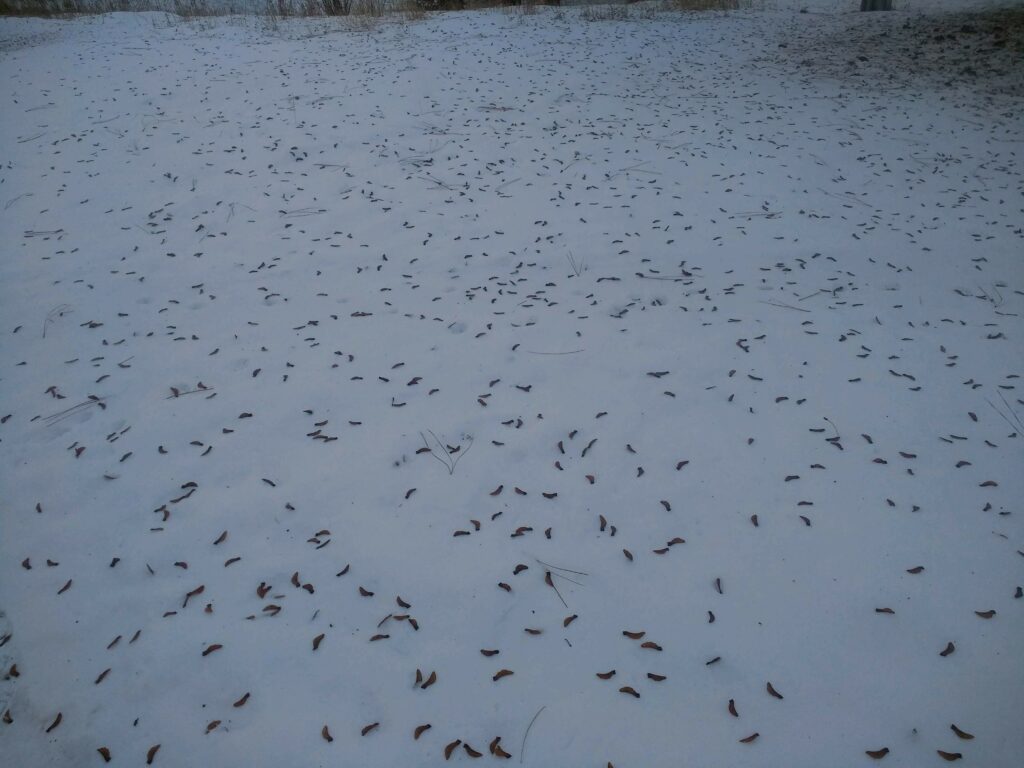
Maple samaras released on January 1st, 2019
It’s too dark in the mornings and evenings to do much work outside. Long needles on the pine trees have turned brown and rain down with every gust of wind. Yellow leaves are joining them. The very long “Indian Summer” has turned cold and wet. It makes me wonder where the time went during some quiet moments – mostly in the middle of the night – when I actually have time to wonder about time.
By the time you read this, the Sunday may have already past when it is time to “Fall back in the Fall,” at the end of Daylight Slaving Time. (Let’s be honest. Lawmakers developed this scheme to boost the economy, so slaving was just as much on their minds as saving.) I’m going to miss it a little bit since waking up hours before breakfast and working outside when no one was likely to call meant getting a lot done.
But it also reminds me of how arbitrary our normal concept of time is. Historians trace the sundial to Egyptians at least as far back as 1500 BCE (“before current era” is now politically correct for “before Christ”). Of course Egyptians no doubt thought that they were the current era back then. Their sun dials had 10 daylight hours and another couple hours on each side for sunrise and sunset. (historyofwatch.com/) Of course this would have been useless in say Alaska where it can be completely dark or completely light. Just sayin’ “Time is Arbitrary.”
Maybe it would be more accurate to say that there are a lot of ways to think of time besides the kind we track with clocks (chronological time). The Farmer’s Almanac can tell you what to expect on a particular day of the year but like this year, the year doesn’t always cooperate, at least around here. Still the length of the day triggers trees to start reserving the nutrients in the leaves. They cut off sap flow and seal themselves for winter. (Smithsonian Institute) Temperature and moisture have a lot to do with the colors.
That is one of the many changing signs of seasonal time. Another that is still a mystery to me happened on New Years Day, 2019. The snow was frozen solid and the leaves had fallen long ago. But the samaras on the maple trees (AKA “helicopters,” “whirlers,” “twisters” or “whirligigs”) suddenly let loose on a very windy cold day. They spread far and wide. With plenty of moisture to work with from the snow, many sprouted that Spring. Usually if I try to figure out natural events, the why will make sense even if the how is not apparent.
You can readily see that the leaves change color near the tops of the mountains before they do in the valleys. Colder temperatures seem to explain that but you can also say that time goes faster at higher altitudes. According to the theory of relativity The stronger the gravity, the more spacetime curves, and the slower time itself proceeds. (wtamu.edu/) So the further away from the center of the earth you are, the faster time goes. There are even arguments about whether time exists at all if there is no gravity. I will spare you (and myself) those. But as I said, time is arbitrary.
Getting into the physics of time leads you to the standard light year. If you are going to measure stellar time, that is the standard. We all learned in physics that nothing goes faster than the speed of light. Except that is not true either. Once in awhile we hear about progress in developing quantum computing which is based on quantum entanglement. This is a topic so complex many state that if you think you understand it, you don’t. It works because once particles are entangled; a change in one will immediately be reflected in a change in the other no matter how far they are separated. “Tests have been performed where the locations were sufficiently separated that communications at the speed of light would have taken longer—in one case, 10,000 times longer—than the interval between the measurements.” (wikipedia.org) So much for the speed of light being the fastest phenomena in the universe.
Meanwhile back at everyday calendars with solar equinox and both a winter and a summer solstice, that feeling of time changing very fast is based on simple geometry. If you shine a light on a world globe and tilt it toward the light, there is always a dark side and a light side, but when tilted very much, the whole top of the globe is always in the light and the south pole is always in the dark. These solstice positions seem to be stuck there in the middle of summer or winter. And actually they are. The length of daylight time changes more quickly at the equinox and the further you are from the equator. So here near 49° north, the length of day changes a lot faster around the equinox. This part of time is not arbitrary.
But clocks are arbitrary. People invented the 24 hour clock, time zones, the 12 hour face of the clock etc. I think it was just really easy to divide the round circle face of a clock into 12 equal parts. But we agreed to it and live by it down to seconds measured by atomic clocks. Truthfully it works well to be able to make appointments and count on ball games being on at a certain time.
Farmers need to keep track of all these kinds of time. We depend on crops, markets and phases of the moon. I should get some sleep and stop thinking about arbitrary things.
